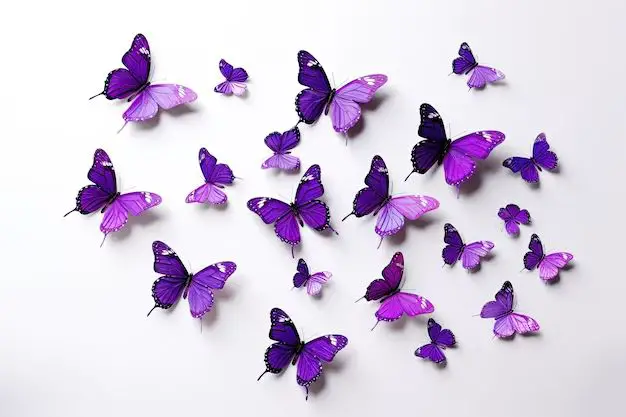There are several different species of purple and violet colored butterflies found around the world. The most common purple butterflies belong to the brush-footed butterfly family, or Nymphalidae. Within this family, the subfamilies Morphinae, Satyrinae, Heliconiinae, Limenitidinae, Nymphalinae, Apaturinae, and Charaxinae contain different purple butterfly species. The coloration in these butterflies is produced by pigments as well as structural colors from scales on the wings. Some of the most well-known purple butterfly species include the mourning cloak, pearly purple emperor, purple hairstreak, violet copper, and more.
Major Types of Purple Butterflies
Here are some of the major groups and species of purple butterflies found around the world:
Morphinae (Morpho Butterflies)
– Morpho peleides (Blue Morpho) – This large butterfly has iridescent blue wings when open, with a violet underside. Found in Central and South America.
– Morpho helenor (Helenor Morpho) – Another large blue morpho species with a bright violet underside. Native to South America.
– Morpho rhetenor (Rhetenor Morpho) – A common morpho butterfly with vivid greenish-blue wings when open and a metallic violet-blue underside. Occurs in Central and South America.
Satyrinae (Satyrs and Browns)
– Elymnias hypermnestra (Common Palmfly) – A south and southeast Asian satyr with iridescent purple-blue upperwings and brown underwings with pale bands.
– Lethe europa (Bamboo Treebrown) – Found in southern India and Sri Lanka, this species has velvety dark brown wings with large pale purple patches outlined in black.
Apaturinae (Emperors and Lesser Emperors)
– Apatura iris (Purple Emperor) – A Eurasian butterfly with dark brown upperwings containing iridescent purple bands and markings. Males are more vividly colored while females have more muted purple hues.
– Apatura metis (Lesser Purple Emperor) – Closely related to the purple emperor, this species is found across North Africa, the Middle East, and Asia. It is also dark brown with prominent purple iridescent bands on the upperwings.
Nymphalinae (Brush-footed Butterflies)
– Vanessa atalanta (Red Admiral) – A common butterfly species, the red admiral has black wings with red, orange, and iridescent blue markings, including prominent blue bands on the forewings. Found worldwide.
– Vanessa virginiensis (American Painted Lady) – Native to North America, this species has orange wings with intricate black, purple, and blue patterns.
Heliconiinae (Passion-vine Butterflies)
– Dryas iulia (Julia Butterfly) – Found from southern USA to South America, this medium-sized butterfly has prominently elongated forewings. It is brightly colored with black, orange, cream, and iridescent blue-violet spots and patterns.
Purple Butterfly Habitats
Purple butterflies occupy diverse habitats depending on the species. Some types can thrive in urban spaces while others require specific natural environments:
– Tropical rainforests – Many purple Morpho species live in the tropical forests of Central and South America.
– Mountain meadows and forests – Butterflies like the purple emperor inhabit deciduous and pine forests in mountainous areas in Europe and Asia.
– Gardens, parks, agricultural areas – Some purple butterflies like painted ladies and red admirals readily visit both natural areas as well as agricultural fields and urban gardens.
– Coastal sand dunes – Dune specialists like the gray hairstreak make use of sandy coastal habitats. Their purple undersides provide camouflage when wings are closed.
– Marshes and wetlands – Species such as the purple marsh crab prefer wetter areas like marshes, swamps, and wet meadows.
What Do Purple Butterflies Eat?
Like all butterflies, purple butterflies drink nectar as adults but have different caterpillar host plants. Some examples of their diet include:
– Nectar from flowers – Common butterfly nectar sources are milkweed, lilac, red clover, daisies, and more depending on location.
– Rotting fruits – Butterflies like morphos drink the juices of rotting mangos, oranges, and bananas to obtain minerals and sodium.
– Tree sap, animal dung, and urine – These provide nutrients like sodium and amino acids. Species like emperors and morphos visit them.
– Caterpillar host plants – Each species has specific host plants their caterpillars must eat, such as snapdragons, passion flower vines, grasses, and nettles.
Interesting Purple Butterfly Facts
Beyond their beautiful coloring, purple butterflies have some fascinating traits and abilities:
– Structural colors – The metallic and iridescent colors on a butterfly’s wings are created by microscopic structures that reflect specific wavelengths of light. This differs from pigment colors that rely on chemicals.
– UV vision – Butterflies can see ultraviolet wavelengths invisible to humans, allowing them to spot nectar guides on flowers.
– Fast flying – Some purple butterflies, like morphos and emperors, are strong flyers capable of reaching speeds over 30 mph.
– Chemical defenses – Certain purple butterfly species sequester toxic plant chemicals in their bodies to deter predators. Their bright colors warn of their bad taste.
– Long lives – Purple emperor butterflies can live for nearly a year, hibernating as adults during the winter. Other butterflies only live for a few weeks as adults.
– Extra “eyes” – Morpho butterflies have markings resembling eyes on their wings that may startle or distract predators.
Conclusion
Purple butterflies add a vibrant splash of color to ecosystems around the world. Their unique structural colors, interesting behaviors, important pollination services, and beauty make them important components of the regions they inhabit. Protecting habitats will ensure purple butterflies continue to brighten our landscapes for years to come. Understanding and appreciating these insects further deepens our connection to the natural world.
| Butterfly Family | Species | Native Region |
|---|---|---|
| Morphinae | Morpho peleides | Central and South America |
| Morphinae | Morpho helenor | South America |
| Morphinae | Morpho rhetenor | Central and South America |
| Satyrinae | Elymnias hypermnestra | South and Southeast Asia |
| Satyrinae | Lethe europa | Southern India and Sri Lanka |
| Apaturinae | Apatura iris | Eurasia |
| Apaturinae | Apatura metis | North Africa, Middle East, Asia |
| Nymphalinae | Vanessa atalanta | Worldwide |
| Nymphalinae | Vanessa virginiensis | North America |
| Heliconiinae | Dryas iulia | North, Central, and South America |


